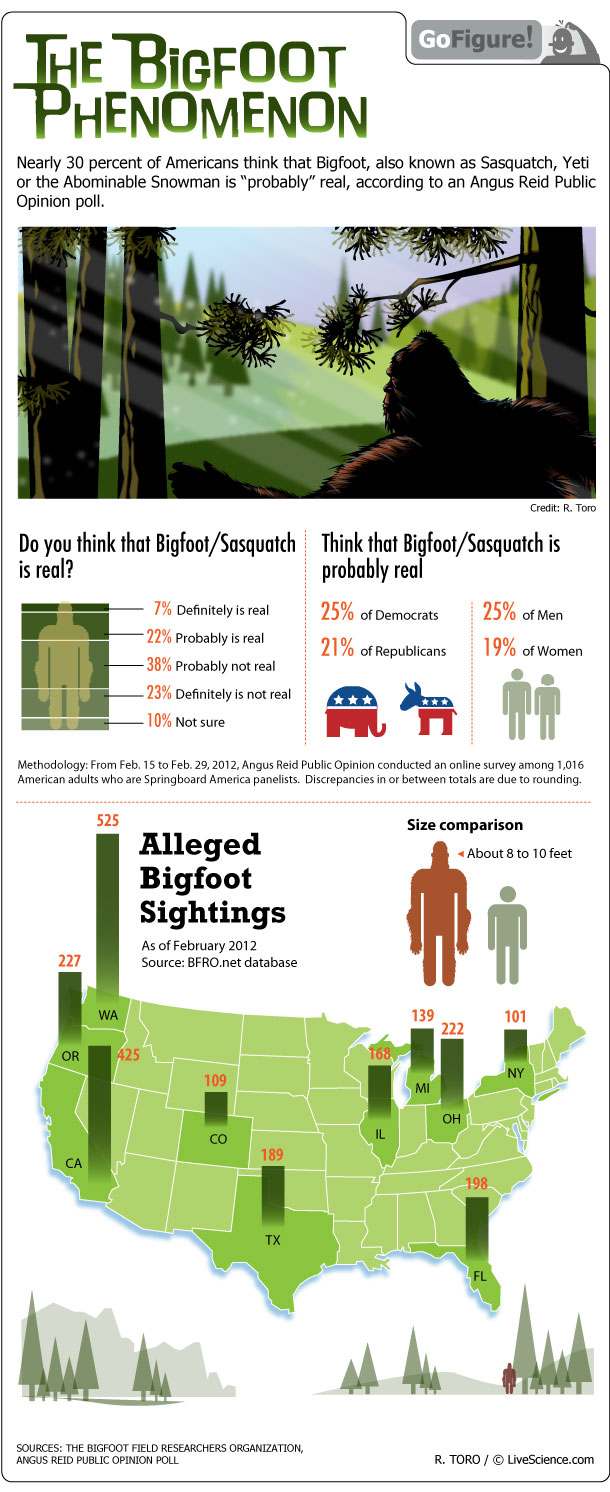Tracking Belief in Bigfoot (Infographic)

The big hairy monster we call Bigfoot has both eluded and fascinated many, with blurry photos and even blurrier video being some of the best evidence the creature exists.
Bigfoot stories of sightings vary on some details and the type of "evidence." In 2008, two Georgia men claimed they had a body, photos of the body and DNA evidence of a Bigfoot. A few days later, evidence surfaced that the DNA was that of an opossum and the body was really a frozen gorilla suit.
More recently in 2011, a Charlotte, N.C.-based man named Thomas Byers claimed that, while driving, he and a companion videotaped a Bigfoot crossing the road in front of their truck and at one point it "made a snarling growling sound and looked back at me," Byers said. Various hints, including the fact that no truck is seen, nor headlights (it was pretty dark in the video), and that the slow-moving creature (or human) seems to be waving in the footage, weighed heavily against the video's validity.
The most famous recording of an alleged Bigfoot is the short 1967 film shot in Bluff Creek, Calif., by Roger Patterson and Bob Gimlin. The video shows a dark, humanlike creature striding through a clearing. It has never been proven real, and in the 45 years since the film was shot, it has remained the best evidence for Bigfoot. (It seems even with today's technology, quality video of Bigfoot is tough to come by.)
And, of course, these sightings are not confined to the United States.
The legendary woodlands ape, though answering to different names, has been a fascination across the globe. For instance, a group of Chinese researchers announced in October 2010 that they were mounting an expedition to seek evidence of the yeren, the Chinese version of Bigfoot. Other searches for the yeren in pior decades all failed to find conclusive evidence of the beast's existence. The team, led by a man named Luo Baosheng, is hoping to raise $1.5 million to launch the search.
The so-called Canadian Sasquatch is essentially the same creature as the American Bigfoot, though it is claimed to be primarily nocturnal and a fast runner. Moving to Asia, the Yeti — formerly known as the Abominable Snowman — is said to live in the forest below the snow line of the Himalaya Mountains. Reports suggest the creature is muscular, covered with dark grayish or reddish-brown hair, and weighs between 200 and 400 pounds (90 and 180 kilograms). Compared with Bigfoot, the Yeti is claimed to be relatively short, with an average height about 6 feet (1.8 meters).
Get the world’s most fascinating discoveries delivered straight to your inbox.
The Down Under variety, dubbed Yowie, reportedly stands anywhere from 5 to 11 feet (1.5 to 3.4 meters) tall, and has yellow or red eyes deeply set inside a dome-shaped head.
This lack of evidence hasn't stopped enthusiasts, however. The reason could be human nature: We want to believe. "The human brain is always trying to determine why things happen, and when the reason is not clear, we tend to make up some pretty bizarre explanations," said Brian Cronk, a professor of psychology at Missouri Western State University, back in 2008.
And our belief in all things supernatural, from fairies and elves to gods, ghosts and monsters, seems to go way back in human history. The reason, say some social scientists, is the human need to explain that which we don't understand.



